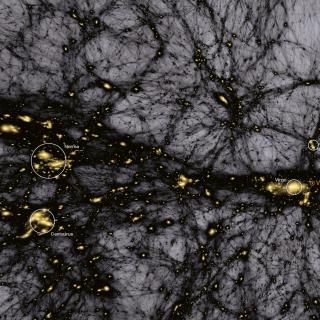Bibcode
Sinigaglia, Francesco; Kitaura, Francisco-Shu; Nagamine, Kentaro; Oku, Yuri
Bibliographical reference
The Astrophysical Journal
Advertised on:
8
2024
Journal
Citations
9
Refereed citations
6
Description
We present the first measurement of the Lyα forest baryon acoustic oscillations (BAO) shift parameter from cosmological simulations. In particular, we generate a suite of 1000 accurate effective field-level bias-based Lyα forest simulations of volume at z = 2, both in real and redshift space, calibrated upon two fixed-and-paired cosmological hydrodynamic simulations. To measure the BAO, we stack the 3D power spectra of the 1000 different realizations, compute the average, and use a model accounting for a proper smooth-peak component decomposition of the power spectrum, to fit it via an efficient Markov Chain Monte Carlo scheme estimating the covariance matrices directly from the simulations. We report the BAO shift parameters to be and in real and redshift space, respectively. We also measure the bias b lya and the BAO broadening parameter Σnl, finding and in real space, and and in redshift space. Moreover, we measure the linear Kaiser factor from the isotropic redshift space fit. Overall, we find evidence for a negative shift of the BAO peak at the ∼2.2σ and ∼3.5σ levels in real and redshift space, respectively. This work sets new important theoretical constraints on the Lyα forest BAO scale and offers a potential solution to the tension emerging from previous observational analysis, in light of ongoing and upcoming Lyα forest spectroscopic surveys, such as DESI, the Prime Focus Spectrograph Survey, and WEAVE-QSO.
Related projects

Cosmology with Large Scale Structure Probes
The Cosmic Microwave Background (CMB) contains the statistical information about the early seeds of the structure formation in our Universe. Its natural counterpart in the local universe is the distribution of galaxies that arises as a result of gravitational growth of those primordial and small density fluctuations. The characterization of the
FRANCISCO SHU
KITAURA JOYANES